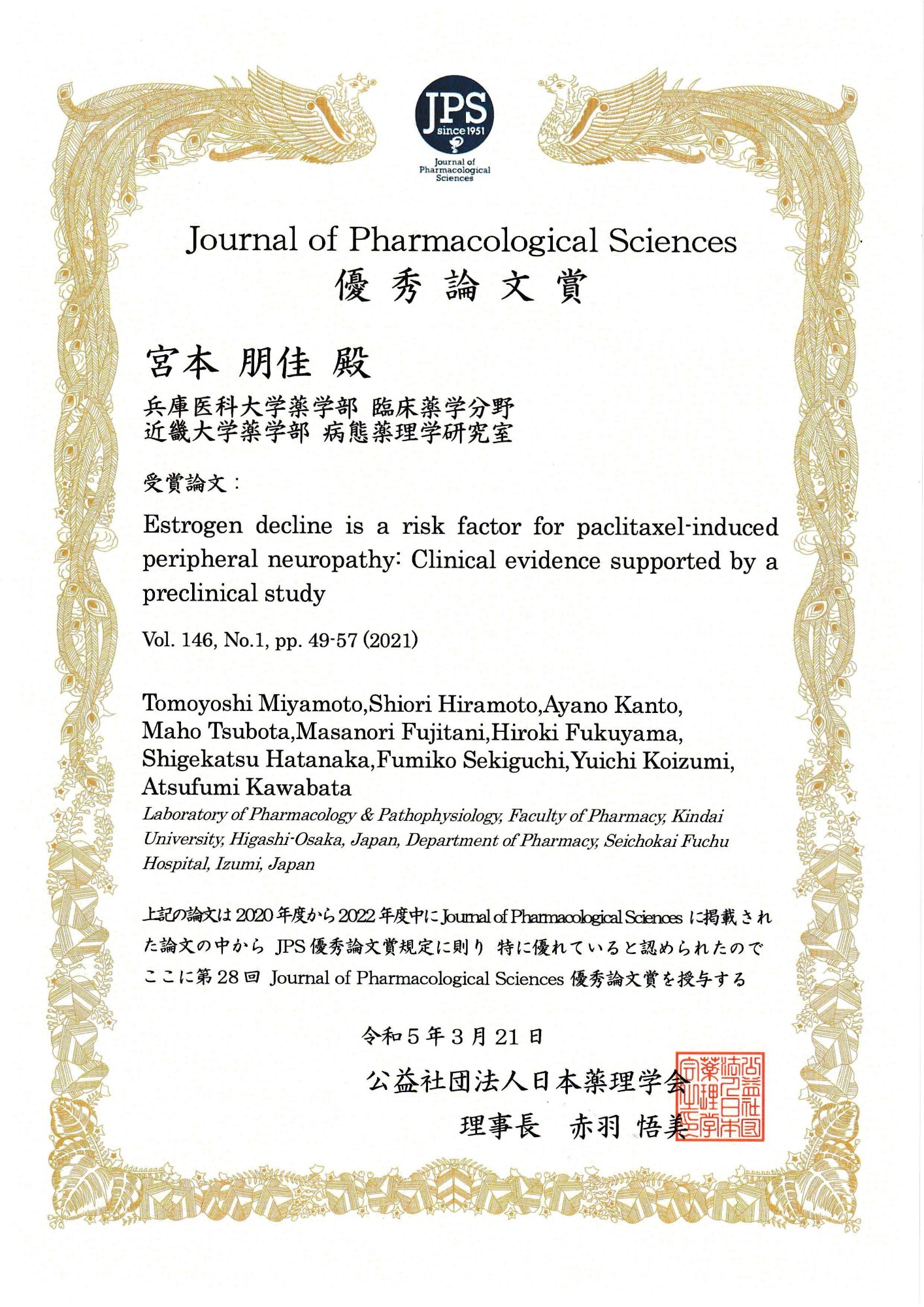Awards
Winner of the 28th Journal of Pharmacological Sciences Outstanding Paper Award (Tomoka Miyamoto, Assistant Professor, Clinical Pharmacy School of Pharmacy)
Tomoka Miyamoto, assistant professor in School of Pharmacy Department of Clinical Pharmacy Pharmaceutical Sciences, has received the 28th Journal of Pharmacological Sciences Outstanding Paper Award.
Name of the awarding organization
Department of Pharmacology
Award-winning Thesis
Estrogen decline is a risk factor for paclitaxel-induced peripheral neuropathy: Clinical evidence supported by a preclinical study
Name of the winner
Assistant Professor Tomoka Miyamoto Clinical Pharmacy School of Pharmacy

Key points of this study
Paclitaxel is a drug that is said to be widely applicable to a variety of cancers, but it frequently induces peripheral neuropathy (PIPN), which can significantly reduce patients' quality of life.
- Developing an appropriate anticancer drug administration plan tailored to each individual's risk is an extremely important issue for continued anticancer drug treatment.
- We found that in breast cancer patients, especially postmenopausal estrogen reduction and endocrine therapy, are associated with severe PIPN.
Conclusions: Non-hormonal Department of Pharmacology interventions for PIPN are needed, and thrombomodulin α (TMα) may be a prime candidate.
Research Overview
In this study, we conducted a clinical retrospective study of female cancer patients and basic experiments using mice to clarify risk factors for paclitaxel-induced peripheral neuropathy (PIPN). In the clinical study, breast cancer patients had a higher incidence of PIPN than non-breast cancer patients, and a subanalysis of breast cancer patients revealed that age 57 years or older and endocrine therapy before the start of paclitaxel treatment were associated with severe PIPN. In the basic study, ovariectomy exacerbated PIPN in mice, but this effect was suppressed by repeated administration of 17β-estradiol. Repeated administration of thrombomodulin α (TMα), which is known to prevent chemotherapy-induced peripheral neuropathy in rats and mice, also prevented the development of PIPN in ovariectomized mice. In summary, breast cancer survivors, especially those undergoing postmenopausal estrogen reduction or endocrine therapy, are considered to be a subpopulation susceptible to developing PIPN, and non-hormonal Department of Pharmacology interventions against PIPN are needed, and TMα may be a major candidate for such interventions.
Research Background
Paclitaxel has a broad range of antitumor activity and is currently used by many patients. However, this drug frequently induces peripheral neuropathy in a dose-dependent manner, significantly reducing the patient's quality of life. The onset of paclitaxel-induced peripheral neuropathy varies from person to person, but it is difficult to predict and there are no preventive drugs. Therefore, elucidating the risk factors for paclitaxel-induced peripheral neuropathy and establishing an appropriate administration schedule of anticancer drugs according to the individual's risk of developing peripheral neuropathy are extremely important issues for continued anticancer treatment.
Research Methods and Results
In this study, we conducted a retrospective study of female cancer patients and basic experiments using mice to clarify risk factors for paclitaxel-induced peripheral neuropathy (PIPN). In the clinical study, we analyzed 131 outpatients undergoing chemotherapy containing paclitaxel to investigate the incidence of PIPN. As a result, the incidence of PIPN was significantly higher in breast cancer patients (n = 40) than in non-breast cancer patients (n = 91). In a subanalysis of breast cancer patients, age 57 years or older and endocrine therapy before the start of paclitaxel administration were significantly associated with severe PIPN (CTCAE grades 2 to 4). In the basic experiment, paclitaxel was repeatedly administered to ovariectomized female mice, and mechanical nociceptive thresholds were evaluated using the von Frey test. Ovariectomy worsened PIPN in mice, but this effect was suppressed by repeated administration of 17β-estradiol. Repeated administration of thrombomodulin α (TMα), known to prevent chemotherapy-induced peripheral neuropathy in rats and mice, also prevented the development of PIPN in ovariectomized mice.
Future challenges
In clinical studies, we explore the factors through which estrogen and thrombomodulin affect paclitaxel-induced peripheral neuropathy.
Publication information
Publication
Journal of pharmacological sciences
Paper title
Estrogen decline is a risk factor for paclitaxel-induced peripheral neuropathy: Clinical evidence supported by a preclinical study
Author Name
Tomoka Miyamoto (Assistant Professor, School of Pharmacy Clinical Pharmacy) and others
Source of research funds etc.
JSPS KAKENHI (26460710/17K09046)
Glossary
*1 Paclitaxel: A type of anticancer drug that is said to be applicable to various cancers, including uterine cancer, breast cancer, ovarian cancer, and stomach cancer.
*2 Retrospective study: A type of observational study used to investigate the relationship between disease factors and onset. It is also called a "retrospective study" because it collects information on subjects retrospectively from the time the survey began.
*3 17β-estradiol: The most powerful natural estrogen for humans and many mammals. It is secreted from ovarian follicles and is known to affect cell differentiation and proliferation, and exerts its effects by binding to estrogen receptors α (ERα) and β (ERβ).
*4 Thrombomodulin α (TMα) Thrombomodulin is a high-affinity thrombin receptor that is mainly present in vascular endothelial cells, and mucosal epithelial cells of the respiratory tract and intestinal tract. Thrombomodulin α was successfully produced by genetic engineering in an attempt to make a soluble molecule from only the extracellular portion containing the active site of thrombomodulin.